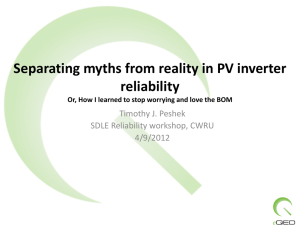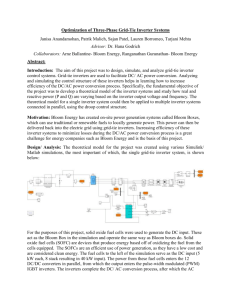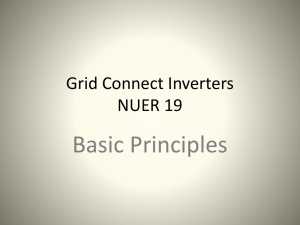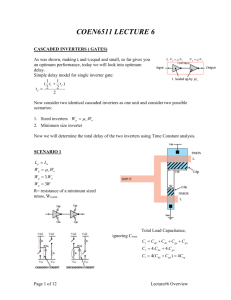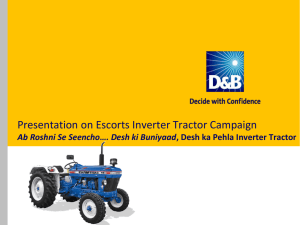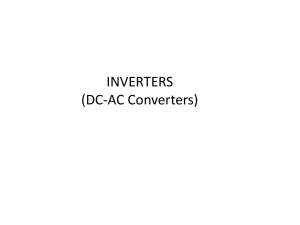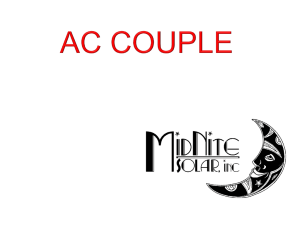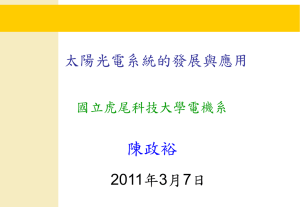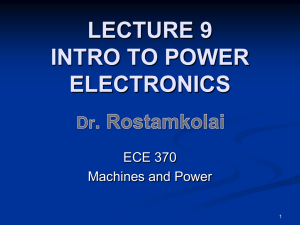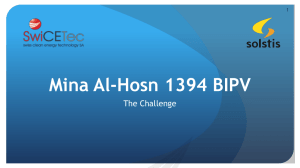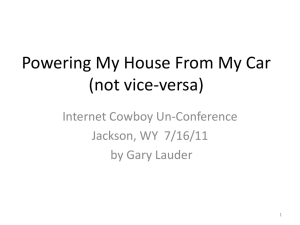Inverter Integrated Options
advertisement
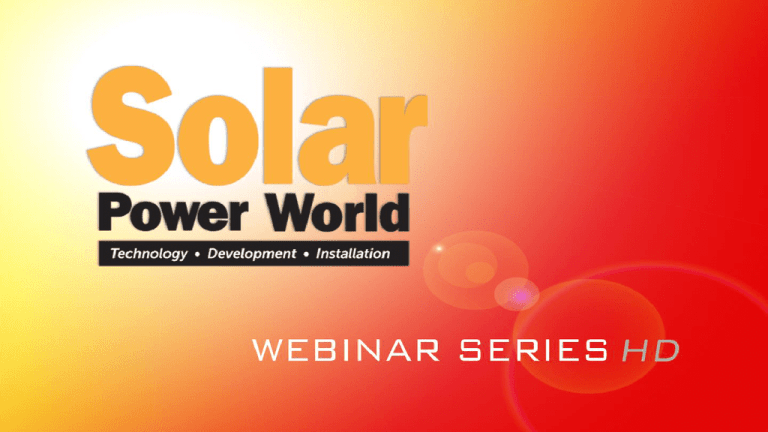
Increasing ROI With Commercial-Scale Inverters Sponsored By: Before We Start This webinar will be available afterwards at www.solarpowerworldonline.com & via email Q&A at the end of the presentation Hashtag for this webinar: #SolarWebinar Moderator Presenters Steven Bushong Jon Fiorelli Scott Kolek Solar Power World Solectria Advanced Energy Opportunities for Increasing ROI of Commercial PV Inverters Scott Kolek – Product Manager - TX Inverters AE Solar Energy Agenda Brief introduction to Advanced Energy ‘Typical’ Large-scale Commercial PV Installation Technologies and Products for ROI Optimization Traditional New Emerging Conclusions and Takeaways Advanced Energy Overview 30-year focus on power conversion solutions • Founded in 1981 in Ft. Collins, Colorado • 5 major sites: Fort Collins, Colorado; Bend, Oregon; Toronto, Ontario; Metzingen, Germany; and • • Shenzhen, China 1571 employees worldwide (as of May 2013) Dedicated service organization 2012 revenue $452M • Ended 2012 with $172.2M in cash, having generated $110.8M of cash in 2012 Market capitalization $676.42M (as of May 13, 2013) • Two business units • AE Thin Films: Power conversion solutions for thin-film plasma manufacturing • AE Solar Energy: PV inverters and energy management solutions • Solid footing in growing solar inverter market • Leadership in North America AE Solar Energy Global Footprint Product Power Levels & Market Segments String Central Integrated Solutions Power: 12 – 24kW Power: 35 – 500kW Power: 500 – 2MW Transformer and transformerless PV inverters, integrated solutions, complementary BoS products, and O&M aimed at lowest cost of energy through project life-cycle Traditional Large-scale Commercial PV Installation Typical Characteristics • Rooftop mounted, 600 VDC Strings • ~12 panels/circuit • DC Combiner Boxes • Pad/Ground-mounted Central Inverters, ~100KW to 500KW range • DC:AC Ratio on order 1.1-1.25:1 • DC Sub combiners (fuses or breakers) integral to inverters • Inverter-level and (sometimes) sub combiner monitoring 3MW Rooftop Solution, Ontario CA 250kW & 500KW Central Inverters 2.4MW Rooftop Solution, Portland OR 100kW & 260KW Central Inverters Traditional Methods – ROI Improvement BoS Cost Reductions Increase Energy Harvest Structural system – optimized for streamlined installation Increase panel performance Reduce install labor - pre-assembly, on-site assembly line, etc. Increased inverter reliability & uptime Reduce O&M Costs – Reliability, increased uptime Trackers Wiring reduction methods (CPT, RPT) MV Applications: Multiple inverters 1 Step up transformer Inverters lifetime = module lifetime Increased inverter efficiency MPPT – Wider range, improved algorithms Use of modeling for design optimization New Methods – Distributed/String Inverters ROI-Enhancing Benefits: Optimal match of power conversion capacity to array capacity – using smaller 15-24kW inverter blocks Eliminate DC Combiner Boxes (note: AC combiners still required) Reduced cost of (commodity) AC aggregation equipment versus low volume/high cost DC equipment Less mounting space. Compact size allows closeproximity mounting to array. No pad or rigging. Multiple MPPT Trackers on each roof offset shading & less-than-optimal array orientations Rapid field replacement serviceability Build-in monitoring capability for each inverter 100kW Rooftop Solution, Piscataway, NJ 20 & 24kW String Inverters New Methods – High DC:AC Ratio Stringing ROI-Enhancing Benefits: Low (and lowering) cost of panels permit higher panel densities at small overall cost impact Utilize higher DC:AC Ratios to increase time at full power and increase Capacity Factor (Actual Energy / Max. Potential Energy) Achieve increased energy harvest in high temperature climates and lessthan-optimal array mounting configurations CEC efficiency & MPPT less relevant in high DC:AC ration systems. DC:AC ratios 1.75-2:1 are available. Emerging Methods – 1000V DC for Commercial UL-Listed installations are happening • Utility, commercial ground mount and rooftop Many developers & EPC’s going to 1kV DC • • Both central and string Projected to become mainstream solution for large commercial applications No NEC barriers, AHJ roadblocks clearing • • 1000 VDC on commercial rooftop and ground mount today with minimal challenges Ambiguity in code slowly being cleared up, acceptance accelerating 1000 VDC equipment selection growing • • Driven by growth of Utility segment Including modules, inverters, combiners, BOS 1000V DC Commercial PV – The Upsides, Downsides ROI-Enhancing Benefits: 20 modules per 1000 Vdc string vs. 12 per string at 600 Vdc in same location = • ~40% less strings for same power, ~40% less combiner boxes, ~40% less home runs Conductor savings • “Amps cost $, volts are free” : This is almost true, 1000 Vdc PV wire costs more that same gauge 600 Vdc wire, but it carries far more energy • ~40% less conductor costs. • Lower voltage drop losses • Less losses from strings to combiners Downsides: Requirement to meet >600V (multiple) sections code can complicate AHJ approval 1000V equipment availability still biased towards large scale utility applications (but changing…) Additional permitting and inspection “hoops” may offset benefits Short cable length & restrictive wiring applications may limit benefits Additional safety & training considerations for higher/1000V Farther out – PV/Battery & Intelligent Microgrids Concept: • • • • Battery storage + PV array become ”dispatchable” power supply asset Enterprise Controls intelligent dispatch generation sources + load controls to optimally-reduce energy costs Solar PV Battery Storage - + + + Inverter Standby Generators Start/Stop Load Level Load Level pF Level Charge/ Discharge Load Level Facility Grid Utility Supply Reduce size and usage of diesel gens for standby power. Reduce UPS. Participate in Energy Markets and sell excess electricity when prices high Hybrid PV/Battery System Enterprise Level Control … Load Shed/Add PCC Utility Master Control Rev. meter, Grid/Island Facility Loads How AE is Addressing the Challenges Continued Product Development • • 1000V Solutions Distributed/String solutions Forward-thinking R&D and Technology Partnerships • • SEGIS-AC and SEGIS: 4 years and counting • Partnering with industry leaders to develop collaborative solutions: PGE, PEPCO, SAFT, NPPT, Sandia, NREL, etc 3+ year relationship with Schweitzer Engineering Lab (SEL) to advance technologies and products related to utility, facility, and PV system integration • Closed-loop controls, advanced anti-islanding, reliability and stability, cyber-security Thinking beyond the Inverter • PowerStation packaging, hybrid power system, energy storage, advanced inverter master controllers, etc. Thank you for your attention! Scott Kolek Product Manager – TX Inverters AE Solar Energy +1.970.492.2028 Office scott.kolek@aei.com AE Solar Energy Headquarters 20720 Brinson Blvd Bend, OR 97701 www.advanced-energy.com/solarenergy Increasing ROI with Commercial Scale Inverters Jon Fiorelli Applications Engineer Solectria Renewables jon.fiorelli@solectria.com Topics Covered 1. Design Considerations… 2. Inverter Integrated Options… 3. Post-Inverter Installation Considerations… …that impact ROI Design Considerations Design Considerations There are dozens of design decisions Cost/Benefit Analysis Financial Model Keep in mind that there are many design decisions that are difficult to quantify There are very few “Rules of Thumb” Project Goals and Challenges Vary Financial Models Vary String Sizing Use Max Allowable String Size to: Reduced BOS Costs (Fewer strings means fewer combiner boxes and fewer source and output circuits) Reduce System Losses (fewer circuits and higher voltage/lower total current) Maximize Production for System Life Ensures that max power voltage of the array will stay within the Max Power Point Tracking range of inverter as modules degrade during the lifetime of the system Of course, using max. number of modules is not always possible or preferred for other reasons (complex layout, odd string size, carport…) Next Stage in Design Evolution: 1000V Systems String Sizing - Design Temperatures Consider using… ASHRAE Temperature (Extreme Annual Mean Minimum Design Dry Bulb Temperature) for larger max string size NEC 2011 690.7(A) Informational Note Read: “Array Voltage Considerations”, B. Brooks, SolarPro Oct/Nov 2010 CHECK WITH INSPECTOR!! SolarABC’s Map Tool www.solarabcs.org/about/publications/ reports/expedited-permit/map/ String Sizing Example Use Solectria PV System Builder (www.solren.com) • • • • Location: Atlantic City, NJ Array Size: 600kW DC Module: Sharp NU-U235F1 Inverter: PVI 500 Record Low/Average High -23°C/29°C 13 Modules Per String 196 Strings ASHRAE -16°C/33°C 14 Modules Per String 182 Strings THAT’S ONE LESS 14-STRING COMBINER!! Oversizing Historically, designers oversize by 10% to 25% optimize kWh/kW (Specific Yield) -> High Module Prices Times have change: Cheaper Module Prices (More production for less incremental cost, same fixed cost) Time-of-Use Utility Rate structures Limiting factor is short circuit current Designers can vary tilt angle, power density, and encroach into shaded regions Definition of “Best” Ratio => Optimizes financial model (IRR, NPV, LCOE) Perform Oversizing Analysis using simulation program (PVsyst, PV*SOL, SAM) which feeds financial model Other Design Decisions Inverter Location (longest run DC or AC?) Inverter Efficiency Module Specs: Efficiency, IP rating, Loading specs Module Tilt Angle/Orientation/Inter-row separation/Power Density Small vs. Large Combiner Boxes Copper vs. Aluminum Wiring Inverter Integrated Options Inverter Integrated Options Save field labor, equipment costs, and engineering/procurement overhead by having inverter options factory integrated. Examples: Subcombiners (Fuses, Breakers) Revenue Grade Meter Monitoring Gateway Card Zone Level Monitoring (troubleshooting value) Same company for inverter/monitoring (troubleshooting value) Post-Installation Considerations Post Installation Considerations Means to Ensure UPTIME and Minimize DOWNTIME Perform Preventative Maintenance Inverter Provider Preventative Maintenance Plans Inverter Provider Uptime Guarantee Monitoring with Fault Notification Alerts Fault Action Plan (Installer, O&M Provider, Inverter Company) Spare Parts?? (Ground Fault Fuse, Subcombiner Fuses) Service and Maintenance Friendly Design (Site Plan Placards, Shade structure, Service receptacles) Thank You! Jon Fiorelli – Applications Engineer Jon.Fiorelli@Solectria.com Don’t forget that Application Engineers can help increase ROI: **Product Knowledge** **Project Experience** Questions? Solar Power World Solectria sbushong@solarpowerworldonline.com Phone: 440.234.4531 Twitter: @wtwh_renewables Jon.Fiorelli@solectria.com Phone: 949.933.6828 Steven Bushong Advanced Energy Scott Kolek Scott.Kolek@aei.com Phone: 1.970.492.2028 Jon Fiorelli Thank You This webinar will be available at www.solarpowerworldonline.com & email Tweet with hashtag #SolarWebinar Connect with Twitter: @SolarPowerWrld Facebook: …/SolarPowerWorld LinkedIn: Solar Power World Group Discuss this on EngineeringExchange.com
